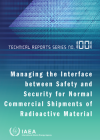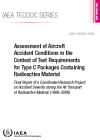Each day thousands of shipments of radioactive materials, including waste and spent nuclear fuels, are transported globally. The IAEA strongly promotes the implementation of its transport safety regulations in all Member States, which has resulted in an exemplary worldwide transport safety and security record for over 50 years.
Transporting radioactive materials
Today, all manner of products that we take for granted are dependent on the safe, secure and reliable transport of radioactive materials from manufacturer to end user. As a result of the increased use of radioactive substances in, for example, industry, medicine and agriculture, shipments have become more frequent and larger in volume. In addition, transport safety and security is vital during all stages of the nuclear fuel cycle - to and from nuclear power plants: at the front end, to transport uranium concentrates and new fuel assemblies; and at the back end, to transport radioactive waste and spent nuclear fuel for storage or disposal.
Transport of radioactive material by its nature gives rise to the risk of accidents with the potential for radiological exposures that could impact the safety of people, property and the environment. While the prime responsibility for safety rests with the organizations responsible for the facilities and activities that give rise to these risks, the IAEA's mission is to establish regulations for the transport of radioactive material by all modes: on land, water or in the air, including transport that is related to the use of the radioactive material. These transport regulations are important for governments, regulators, operators of nuclear facilities, carriers, users of radiation sources and cargo-handling personnel.
The scope of IAEA's transport regulations includes transport package design and composition, material categorization, documentation, labelling and container marking. The regulations deal with specific transport activities, including actual shipments, special arrangements and the transport index number assigned to a package to provide control over radioactive exposure. They also cover the conveyance, whether by road, rail, water or air to, through and across country borders.
In short, the IAEA fulfils its mission by promoting exacting international safety standards and transport regulations, and by providing for their correct application through intensive training and expert advisory services to Member States. The end result of these efforts is the efficient and effective regulation of safety and security by Member States during the worldwide transport of radio-pharmaceuticals needed for hospitals, sealed radioactive sources needed in industry, and during the movement of containers carrying spent nuclear fuel from operating and decommissioning nuclear reactors. As a result, in over 50 years there has never been a transport incident that has caused a significant radiological hazard to people or the environment.








